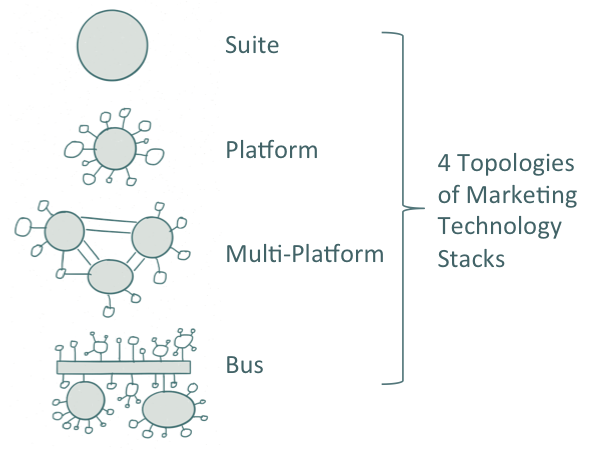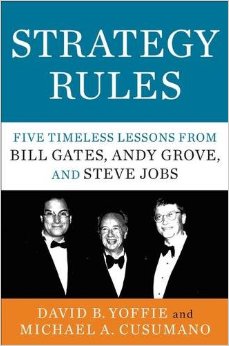“Bill Gates got it immediately. It took Andy Grove 10 years to figure it out, and 20 years for Steve Jobs.”
That quote in The New York Times by David B. Yoffie, Harvard strategy professor and co-author of a new book, Strategy Rules: Five Timeless Lessons from Bill Gates, Andy Grove, and Steve Jobs, immediately caught my eye. (Hat tip to M.G. Siegler.) What was “it” that these three titans of technology ultimately all figured out?
Platforms and ecosystems.
As the article explains, “In digital-age competition, the long goal is to establish an industry-spanning platform, rather than merely products. It’s platforms that yield the lucrative flywheel of network effects, complementary products and services and increasing returns. The payoff is market power and huge profits.”
The Windows operating system is the quintessential example of a “platform.” It was the critical mass of third-party developers, i.e. ISVs (independent software vendors), who made Windows the OS that everyone wanted, because it had the most software available for it. And because it was the most popular OS, software developers wanted to create their products on top of it. It was a virtuous cycle, and Microsoft dominated with it. Intel created a similar platform at a hardware level, and again, dominated their market.
Apple resisted that approach for a while. “Jobs was always a product first, platform second kind of guy,” the Times quotes Yoffie as saying. The article notes that Jobs “preferred beautifully designed products that worked in splendid isolation. But even he eventually grasped the value of platforms.”
A huge factor of the success of the iPhone and the iPad is their support for ISV-developed apps. The App Store has millions of these apps, which Apple now proudly touts. It’s no longer enough for a potential competitor to out-design or out-engineer Apple for an individual product — they’d have to overcome the incredible momentum of all those third-party apps.
That’s the power of platforms. In the book, Yoffie and his co-author Michael Cusumano — a professor at MIT who is an expert on software strategy and business models — note that a new generation of tech titans, including Larry Page of Google, Mark Zuckerberg of Facebook, Jeff Bezos of Amazon, and Huateng Ma of Tencent, are also thriving through platform thinking.
You know who they don’t include as an example of platform success?
Any of the major marketing technology companies. Hmmm.
The Evolutionary Effects of Weak Marketing Technology Platforms
When marketing technology began to take shape as a potential market at the beginning of this century, many of the large enterprise software players pursued a strategy of a closed “suite.” The idea was to offer a solution from single vendor that did everything marketers would need — all perfectly integrated, perfectly controlled. You can imagine Steve Jobs from an earlier era, proud of his pristine product, unsullied by outside developers.
Unfortunately, the scope of marketing exploded at such a phenomenal pace over the past decade — a kaleidoscope of fragmentation, innovation, and differentiation — that it became impossible for any one company to do everything that marketers wanted or needed.
Observing those dynamics in my marketing technology landscape, I strongly encouraged the leading vendors to shift to more of an open “platform” strategy. I believed that there was an incredible opportunity for one or a few of them to create the equivalent of Windows-like or iOS-like ecosystems that would deliver tremendous value to marketers, marketing technology ISVs, and, most of all, those platform companies.
The results have been mixed. Salesforce played the platform card early — and at least within the CRM space, it has had the largest market share (18.6% as of last year). Marketo made a big public commitment to being a marketing platform and has probably the largest ISV community within its LaunchPoint partner program. Oracle Eloqua, Adobe, Salesforce ExactTarget, HubSpot, IBM, Act-On and others have all made moves to provide APIs to third-party developers and, in some cases, even an app-store-like marketplace for ISV products.
But for many, it seems like platformization has remained a secondary objective. In some cases, their APIs are rather limited. In other cases, there’s no real “marketplace” where ISV products are promoted. Many have been highly ambiguous about what would be in their platforms and what would be white space for ISVs. And in almost all cases, their platform-ness is far from the centerpiece of their marketing strategy. Most still emphasize everything that they do in their own product portfolio — support for ISVs products or “integrations” is treated as peripheral to their primary positioning.
Maybe they have good reasons for this. I suspect many believe that since marketers crave simplicity in such a complex world that de-emphasizing ISV products is a way of simplifying their value proposition. Many of their salespeople, especially at enterprise-class companies, have their hands full talking about their own products — they don’t want to distract buyers by bringing up other vendors, even synergisitic ISVs.
Whatever the reason, the result has been that while many of these are platforms, they are weak platforms. Don’t get me wrong — they’re certainly powerful systems. By “weak,” I just mean that they don’t have the same dominant kind of network effects that we’ve seen with Windows or iOS. Most marketers think of them as products, not platforms.
Ironically, I believe this has created more complexity in the market.
In the absence of an oligopoly of strong platforms as the foundation of marketing technology, we’re now seeing the rise of multiple specialist platforms.
Look at the marketing technology stack of a major company, and you’ll often see three or more “platforms” in their environment:
- a CRM platform
- a marketing automation platform (MAP)
- a web experience platform and/or e-commerce platform
- a social relationship management platform
- a data management platform supporting adtech
When you look at the investment strategies of leading marketing technology venture capitalists, they clearly seem to believe that there’s room for multiple multi-billion dollar specialist platforms within the marketeing domain. Social relationship platforms (SRPs) seem to be the hottest example of this at the moment. Sales enablement — or more broadly, ways of bridging marketing and sales — is emerging as another hot area of platform-thinking.
As this gains momentum — and, in particular, as these specialist platforms develop their own ISV ecosystems — it will be increasingly difficult for a single master platform to dominate. Even if a major enterprise acquires a bunch of these mini-platforms, the work required to synthesize them into a single, cohesive platform will be daunting. It’s possible that may happen in time. But on the visible horizon, enterprise marketing environments are looking more and more like multi-hub-and-spoke topologies.
A similar, but slightly different model, is arguably an even more open “bus” architecture. Tag management companies like Tealium, Ensighten, and Signal, as well as enterprise service bus (ESB) companies such as Mulesoft, are championing this approach. These companies are specializing in manging the flow of data across multiple platforms and stand-alone products. The difference between a bus and a platform is subtle, but I’d say that the bus model is distinguished by its primary emphasis being on that flow across heterogeneous components in a marketing stack, rather than its own marketing execution capabilities.
Some customer data platform (CDP) companies — as defined by David Raab — also feel like they’re as much a bus as they are a platform.
I believe that the emergence of these multi-platform and bus topologies in marketing technology is a logical result of weak platforms. In the absence of a solid center of gravity for marketing innovation, these other models have been given the evolutionary opportunity to flourish. And now that the genie is out of the bottle, I think it’s going to be difficult to cork it back in.
However, that’s not necessarily a bad thing. The absence of a strong platform oligopoly gives more market power to the buyers of marketing technology — and to the innovators of new marketing software. Strong platforms have many benefits, but they are a lot like benevolent (or not so benevolent) dictators. There’s a good reason why Microsoft was prosectued for anti-trust violations with their Windows platform.
Yes, multi-platform and bus topologies are a little more complicated. But in many ways, they are more flexible. And with marketing technologists increasingly a part of marketing teams, they’re becoming more manageable.
It will be fascinating to see where things go from here.









It’s interesting that we’re starting to see these types of questions being asked about predictive solutions as well. There’s so much confusion for marketers to get their heads wrapped around what a “platform-strategy” actually entails, however, if you don’t start to develop that mindset before purchasing a solution you might be setting yourself up for a long, drooling, uphill battle – especially when it comes to the world of Marketing Automation.
Today’s MA systems are not “light” solutions. They require expert operators to run efficiently, and make sure that they are on-boarded properly. Before you thinking about purchasing any piece of marketing technology, one should think to themselves – how does this scale? The question of scale will help you answer the question of “what’s my platform strategy?” Are you purchasing more of standalone application, or is this technology something that will integrate with a larger whole?
As a modern marketer, if you are not thinking about how systems will talk with one another, and grow together you’re in trouble. It’s painful to make mistakes in choosing MA systems. As mentioned previously they are resource hogs, and are not easy to rip out once they are in place. A lot of marketers don’t spend the time to consider these factors when making their purchasing decision, which ends up costing them dearly down the road – in both human-hours and additional IT costs.
The same logic should be applied when entering the world of Predictive as well. Take a look at a vendor’s customer portfolio, are these the types of customers who have playbooks that are relevant to my business? How is this technology going to grow over time, is it more of an application, or is this a platform? Looking at the customer portfolio in my mind is a part of a “platform.” It’s important to understand not just that the technology will scale, but that there is an active customer community with relatable brands to grow with you.
It’s important no matter what type of marketing tech you’re purchasing that you look at the word “platform” with a lens of scrutiny. Buzz words can be dangerous, and you want to make sure that you are dealing with a vendor that has actually built a “platform” that can scale with your business.
Very good thoughts around marketing platforms Scott. Choosing platforms is definitely a complicated and painful process not only in marketing but in every single space. At least that has been my experience working with and evaluating a variety of platforms, be it in finance domain or gaming or marketing. And I think partly the reason is that in the end platforms themselves are “closed”. By that what I mean is that by choosing a platform you restrict yourself to the APIs and standards and specifications put forth by the platform. There’s nothing wrong about it except that if ever (at all) I need to make a change to make the platform better, I can’t.
And platforms and their architectures themselves are not to fully blame here. The reality is that today’s businesses are in a very dynamic and changing environment than say 50 years back. Due to that their marketing needs change more often than they can handle. I have seen situations where you pick a marketing platform and by the time you are done integrating it into all your systems, your company’s strategy changes completely and now you have to make changes in your integrations, some of which tend to now be more painful than you thought in the beginning. Had the changes occurred slowly (say like it used to say 50 or 100 years back), you’d still have enough time to manage the change. This need of being able to make changes quickly introduces bad habits and poor quality of integration into your entire system. Things that could have been say REST API calls are done with good old batch jobs. Requests and responses that could have possibly followed some industry standard is thrown away in favor of saving time and doing things quick and dirty. And over time, this whole process, done over and over again, brings down the value that the platform was supposed to provide. Imagine if 1/2 of the apps on apple store had bugs because people just keep pushing bad and buggy apps. In the end people would stop respecting the store (and the platform) itself!
I think we already have solved the problem “standardizing” and “bus-i-fy-ing” (that’s the term I used to use a lot back in the days when my world was completely filled with Enterprise Service Buses – everyone wanted to jump onto some “bus” that would magically streamline their processes…) things. The next wave will be around how quickly the platforms are capable to adapt to changing marketing strategies and market dynamics. Platforms that will allow quick and easy changes without having businesses compromise on quality will prevail.
Great article, Scott.
As for the strongest marketing platform, I argue that Oracle has the industry’s largest marketing technology ecosystem: New additions to the Oracle Marketing Cloud AppCloud (260 best-of-breed apps for marketers) and Oracle BlueKai Data Partner Program (200+ direct integrations) help marketers to more easily deliver cross-channel campaigns, capture and track the digital body language of prospects and customers, develop actionable insights, and extend the reach of marketing campaigns.
Acknowledged: Oracle has an awesome marketing platform and a very robust marketing technology ecosystem.
Thank for this great piece of work Scott. This is definitely very inspiring. That said I believe before creating your own platform and ecosystem you need a certain level of success and a critical mass of interested users before developers want to develop over your platform. Finally, to bootstrap your platform, you need to be your first developer and show the path to prove it can be successful and people can make money over it.
At Podbox we really feel the multi-platform approach is inevitable as all the major SaaS editors are playing this card with a marketplace at most or APIs at least. This makes a more and more complex world with some data everywhere. Subscribers in the email-marketing tools, leads in the CRM, customers in the e-commerce and so on…
But how to maintain my data, e.g. the contacts, up-to-date between all these tools? As you mentioned in your article some integrations natively exist between Apps but it is still too few! Most of the possible combinations are just not covered. This is pretty annoying. This means that when I want to send a newsletter, I first have to select and export my data from my CRM like Vtiger or Salesforce as a CSV, do some cleaning job in Excel then import it into my Email Marketing tool like Aweber or Mailchimp in a new list. Or I need to write in the internal processes for my sales guys that, when they convert a prospect into a customer, then have to change his status in Hubspot as well (what they will never do… Okay… “So just notify me!”)
I dream of a internet world full of cloud apps we could seamlessly integrate! And that is pretty cool you mentioned Mulesoft because their integration ESB is able to integrate almost anything with complex scenarii, if you are a developer. Actually I find the Mulesoft approach is really good for complex Enterprise class integration. But I think data integration can be seen as something simpler: what do we all want in the end? We want our data to be up-to-date, everywhere, forever. It’s finally data syncing that is really need, two-way syncing between a set of application with a simple mapping! No coding.
Actually, that’s exactly what I’m working on currently: making my dream come true! This is called Podbox (www.podbox.com) and anyone who wants to be a part of the adventure in any way is welcome!
Thank you for reading, this is much longer than I expected to write but I think it was worth it.
Dom
Good summary Scott of the current dynamics of marketing. I think a primary driver of the lack of platform is the rapid evolution of marketing across different channels which is spawning new data management platforms and mechanisms for targeting and messaging. The net result is that as fast as the big players buy products and services ( e.g Oracle and salesforce) they struggle to stay leading edge.
Nonetheless I think we are seeing predominately your oligopoly of platforms as a starting point being rapidly overtaken by bus type architecture as the need to integrate with other systems and expose APIs starts to dominate.
However, the emergence off a driver towards integrated decisioning across different messaging could drive the emergence of data and decisioning platforms as DMPs converge on CRM. These data platforms could then spawn a model for ISVs to develop apps to access the data and drive the messaging. As Daniel mentions BlueKai could be an example, of such a model.
a little late to this party, but thank you Scott, for helping me even better articulate why I’ve been nose to grindstone working on exactly this topic for the last year. We at Lumiary are a long way from realizing the goal of platform and are more focused on the bus architecture for now. Proceeding cautiously as we find B2C companies who perceive the value in a bus system. A hard part in itself is what to call it. Is it a CDP, a dynamic (in/out) CRM, a realtime data pipeline. Would love your thoughts.